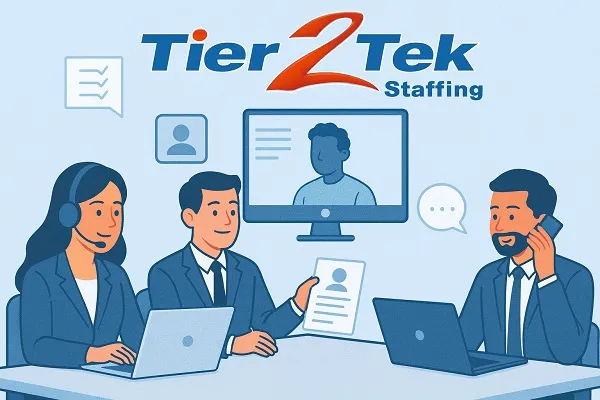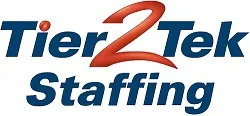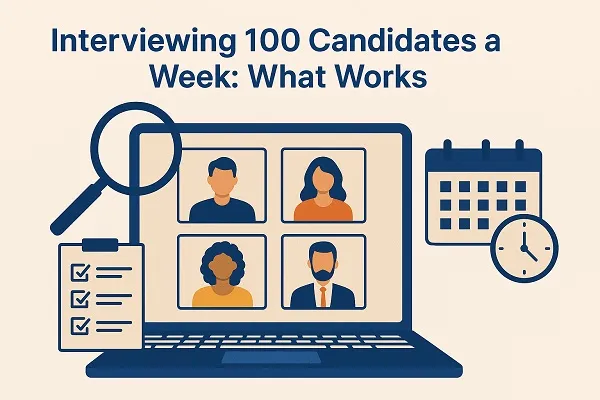Interviewing 100 candidates a week requires precision, structure, and a process that eliminates inefficiency. High-volume hiring is a challenge that tests a company’s ability to balance speed with quality. Organizations that consistently meet ambitious hiring targets rely on data-driven interview strategies, structured processes, and the right technology to stay ahead.
Building a Streamlined Interview System
A high-volume interview process cannot rely on ad-hoc scheduling or inconsistent screening. Successful hiring teams standardize every step.
Standardized Screening Criteria
Consistency is essential when reviewing large pools of applicants. Defining clear, measurable screening criteria helps teams evaluate candidates fairly and quickly.
- Identify the top three non-negotiable skills for the role.
- Use a weighted scoring system to compare candidates objectively.
- Implement automated pre-screening questions to filter unqualified applicants.
Efficient Scheduling Practices
Managing interview slots for 100 candidates a week requires coordination. Recruiters who succeed at scale rely on:
- Automated scheduling tools integrated with calendar systems.
- Defined interview windows each day to prevent overlap.
- Clear time limits per interview to ensure every candidate receives equal focus.
Leveraging Technology to Handle Scale
When interviewing 100 candidates a week, technology becomes the foundation of operational success.
Applicant Tracking Systems (ATS)
An ATS organizes candidate data, tracks interview stages, and ensures no applicant slips through the cracks. A robust system should:
- Enable custom tags and filters for skill level, experience, and source.
- Allow recruiters to automate follow-ups and reminders.
- Provide analytics on time-to-hire and candidate conversion rates.
Video Interviewing Platforms
Asynchronous and live video interviews cut scheduling time dramatically. Recruiters can review recorded responses and score them using predefined metrics. This method improves candidate throughput without sacrificing quality.
Interview Intelligence Tools
AI-driven platforms help identify high-potential candidates by analyzing tone, clarity, and confidence during responses. While human judgment remains critical, these tools accelerate decision-making and maintain consistency across interviewers.
Structuring Interviews for Maximum Efficiency

Interviewing 100 candidates a week requires more than just scheduling discipline—it demands a consistent format that brings out comparable insights.
Role-Specific Interview Frameworks
Developing structured question sets aligned with job requirements prevents bias and ensures repeatable results. Each interviewer should have a clear understanding of:
- Core competencies being evaluated.
- Behavioral and situational questions that reveal decision-making skills.
- A standardized scoring sheet to capture results efficiently.
Time Management During Interviews
A tight timeframe means every minute counts. Keep each interview focused:
- Quick introduction (1–2 minutes).
- Key skill questions (8–10 minutes).
- Behavioral examples (5 minutes).
- Candidate questions (3–5 minutes).
Shorter, structured sessions provide enough data to assess fit while keeping the process moving swiftly.
Maintaining Candidate Quality at Scale
Speed can never come at the cost of quality. Companies that successfully interview 100 candidates a week maintain a balance between volume and selectivity.
Pre-Interview Assessment Tools
Online assessments filter candidates before interviews even begin. They test technical, cognitive, or behavioral traits and help ensure that only qualified applicants move forward.
Interviewer Training
Every interviewer must be aligned on evaluation standards. Training should focus on:
- Reducing bias through consistent scoring.
- Asking probing questions that reveal skill depth.
- Recognizing potential beyond the résumé.
Data-Driven Decision Making
Tracking metrics such as offer-to-acceptance rate, time-to-decision, and interview-to-hire ratio highlights bottlenecks. These insights enable faster iterations of the process.
Creating a Positive Candidate Experience

Even at high volumes, candidate experience influences employer branding. Interviewing 100 candidates a week should not feel impersonal or rushed from the applicant’s perspective.
Communication is Key
Transparent communication keeps candidates engaged and reduces drop-off.
- Send immediate acknowledgments after applications.
- Provide realistic timelines for feedback.
- Offer post-interview updates, even when a candidate isn’t moving forward.
Personalization Through Automation
Modern recruitment software allows for personalized messages at scale. Small details—such as using the candidate’s name, referencing their skills, or explaining the next steps—make a large process feel human.
Respecting Candidate Time
High-volume hiring often overwhelms candidates with scheduling requests or delays. Respecting their time builds goodwill and trust. Provide flexible interview slots and concise feedback.
The Role of Data and Metrics
Data transforms interviewing 100 candidates a week from a logistical challenge into a strategic advantage.
Key Metrics to Monitor
- Time-to-Hire: Measure efficiency across roles and recruiters.
- Interview-to-Offer Ratio: Identify how many interviews lead to offers.
- Candidate Drop-Off Rate: Understand where candidates disengage.
- Source Performance: Determine which recruitment channels bring quality applicants.
Continuous Optimization
Regularly reviewing analytics allows recruiters to fine-tune their approach. If a specific interviewer’s success rate is low or a job posting attracts poor fits, adjustments can be made immediately.
Managing Recruiter Workload
Handling 100 interviews per week demands discipline and energy. Burnout becomes a real risk without the right structure and delegation.
- Rotate interviewers weekly to prevent fatigue.
- Use templates for feedback and scoring.
- Schedule dedicated review blocks to make hiring decisions collectively.
- Encourage team breaks and micro-rewards to maintain motivation.
Building a Consistent Employer Brand

Every interaction with a candidate reflects the organization’s identity. Even in a high-volume process, consistency strengthens the brand.
Unified Messaging
All interviewers should communicate the same company values, mission, and expectations. Consistency reduces confusion and creates a professional impression.
Feedback as a Branding Tool
Offering constructive feedback to unsuccessful candidates builds long-term goodwill. Many will reapply or refer others if treated respectfully.
Tracking Candidate Sentiment
Use surveys or post-interview feedback forms to understand how candidates perceive the experience. Positive experiences often translate into better Glassdoor reviews and stronger applicant pools.
Interviewing 100 candidates a week is less about sheer numbers and more about mastering efficiency without losing the human touch. Organizations that combine automation with structured evaluation consistently hire better talent at scale. By refining processes, empowering recruiters with the right tools, and maintaining empathy throughout the candidate journey, companies can turn high-volume interviewing into a competitive advantage.
Content reviewed and published by Tier2Tek Staffing Editorial Team .

